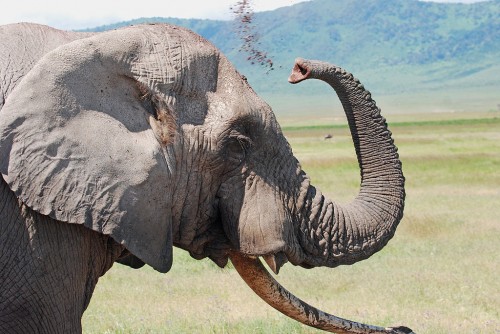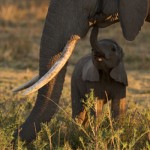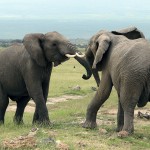
People may be welcoming the announcement that China has apparently banned, for one year, the import of ‘African ivory hunting trophies’[i]. I have to be honest and admit that my immediate, cynical old cop reaction, was that this was just a political gesture, with little meaningful impact.
After all, or so I thought, Chinese nationals do not, historically, form a significant proportion of those individuals from the nations of the world who engage in ‘big game’ hunting and, especially, those who seek to kill, and subsequently acquire, trophies of Africa’s ‘Big 5’[ii]. Indeed, I recall during one of my many visits to China learning that the government had halted any ‘trophy’ hunting of animals within its own borders. Consequently, I thought the likelihood of persons from China being engaged in elephant hunting in Africa would be remote and, thus, any ban would be little more than a PR exercise.
However, I then decided to look at available information. One of the most marvellous sources of information is the CITES Trade Database[iii]. It produced some statistics that radically altered my thinking.
Since 2004, the CITES Management Authority of China has apparently authorized about 70 separate imports of elephant-related hunting trophies.
In 2004, 2005, 2006 and 2009, the authorizations were one per year. However, more recently, the annual authorizations have been multiple.
I need to emphasize right now that CITES Trade Database figures are open to interpretation and cannot be relied upon outright, since the way in which countries submit information is not consistent and can sometimes be very conflicting. But the mere fact that seventy import authorizations have taken place in the last few years must surely be significant? Particularly from a country with no significant tradition of big-game hunting?
And some of the information is really puzzling. Most ‘trophy’ hunters seek a particular part of the animal as a ‘souvenir’ of their hunt. In the case of a big cat, they usually want the whole skin, after it has been treated by a taxidermist. If they’ve shot a rhino, they want its horns, to display ‘mounted’ on a plaque. Elephant hunters will usually request the tusks of the animal they have shot, although some will also want additional body parts, such as the feet (which can be converted into a receptacle for walking sticks, umbrellas, etc.).
CITES export permits and certificates, in relation to hunting trophies, will (understandably and appropriately) be issued to an individual, the hunter, and one would expect what is authorized to reflect that, i.e. body parts which an individual hunter would acquire.
The Chinese CITES Trade Data does not reflect what one might expect at all.
- One import authorization in 2011 related to 216g of ‘carvings’. Another, in 2012, quotes 1240.2g of ‘carvings’. (How many hunters would wish their trophy tusks to be converted into carvings? And why get that done in Africa, when the master carvers are in your homeland?)
- In 2012, China records one import as being 6 tusks, whilst the exporting country records the same trade authorization as being an export of 20 tusks. (A hunter will normally be licensed to hunt one elephant – how could he/she legally acquire 6 tusks, i.e. have killed three elephants? And how could he/she legally kill 10 elephants to obtain 20 tusks?)
- One import report in 2013 quotes 315kg of tusks, whilst the export report quotes 2,138kg.
- One import and export report in 2012 quotes 54 ears imported and 56 ears exported. (How could one hunter obtain such a large number of ears? That must mean at least 25 elephants were killed. By one person? Surely not.)
- One 2012 record quotes an import of 72 feet, whilst the export record quotes 76 feet. (How could an individual hunter legally acquire such a huge number of elephant feet?)
- In 2012, an import record quotes 118 ‘skins’, whilst the exporting country has reported 586. (How could such numbers reflect legal hunting?)
- In 2012, an import record quoted 147kg of tusks, whilst the export record is 2,138kg.
- In 2014, there is a report from an exporting country of 20 tusks, with no linked import record. (How could one hunter possibly be licensed to kill 10 elephants – especially as the exporting country in question had apparently banned game hunting?)
If you care to take the time to examine the trade data, you will presumably be as puzzled as me. The examples I quote above relate to individual permit issuances. (It is immediately apparent, if you study the data, that Zimbabwe is the most significant exporting country to China.)
I wish to repeat that interpreting the CITES Trade Database is problematic. The apparent discrepancies and contradictions may be simple mistakes; all these movements of elephant parts may have been entirely legal and complied with the provisions of the Convention. If so, it illustrates why CITES Parties need to carefully address how they report trade in future and follow the Secretariat’s guidance much more rigidly. But it also demonstrates that monitoring trade using data which is more or less gobbledegook is next to impossible.
On the other hand, and having put my suspicious old cop hat on, I think this deserves closer examination by relevant authorities.
Experience has shown us that pseudo-hunting was a major problem with regard to the trafficking of rhino horns. Is pseudo-hunting of elephants taking place? Are the ‘trophies’ authorized for import into China still in the possession of the ‘hunters’ or have they entered illicit trade?
Maybe someone would like to look into this?
[i] http://www.reuters.com/article/2015/10/15/us-china-ivory-idUSKCN0S90BB20151015
[ii] https://en.wikipedia.org/wiki/Big_five_game
[iii] http://trade.cites.org/



![The UN’s Lone Ranger: Combating International Wildlife Crime [Podcast]](https://annamiticus.com/wp-content/uploads/2015/10/BehindTheSchemesEpisode37-500px-150x150.png)
